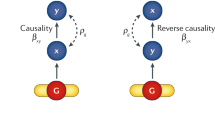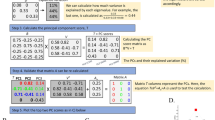Abstract
IN anthropological surveys, investigations of the effects of mutagenic agents, and similar projects, the transmission of hereditary characters is frequently investigated in large populations. Where data are available it is advisable to ascertain whether the children's phenotypes agree with those of their presumptive parents. Lack of agreement indicates that the data were influenced by factors other than family relationships, for example, illegitimacy, errors of labelling, technique or recording, or the effects of mutation. The greater the number in the group, the more likely are the factors producing disagreement to be identified, but the more burdensome becomes the labour of correlation.
This is a preview of subscription content, access via your institution
Access options
Subscribe to this journal
Receive 51 print issues and online access
$199.00 per year
only $3.90 per issue
Buy this article
- Purchase on Springer Link
- Instant access to full article PDF
Prices may be subject to local taxes which are calculated during checkout
Similar content being viewed by others
References
Colman, H. L., and Smallwood, C., et al., Computer Language (McGraw-Hill, New York, 1962).
Dijkstra, E. W., A Primer of Algol 60 Programming (Academic Press, London, 1962).
Webster, J., 1620 Forcom Subroutine Writeup, Library Program No. 1620 01.6.074 (Program Distribution Center, I.B.M. Inc.; P.O.B. 790, White Plains, N.Y., U.S.A.).
Author information
Authors and Affiliations
Rights and permissions
About this article
Cite this article
BAUMGARTEN, A. Computer Analysis of Concordance of Inherited Characteristics. Nature 205, 109–110 (1965). https://doi.org/10.1038/205109a0
Published:
Issue Date:
DOI: https://doi.org/10.1038/205109a0
Comments
By submitting a comment you agree to abide by our Terms and Community Guidelines. If you find something abusive or that does not comply with our terms or guidelines please flag it as inappropriate.



